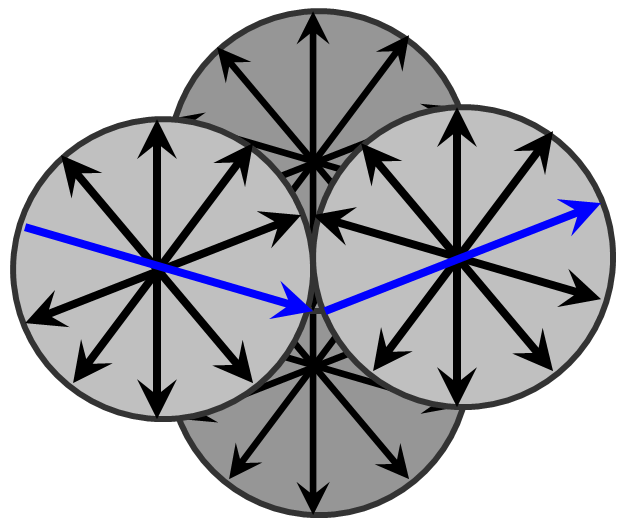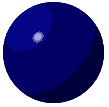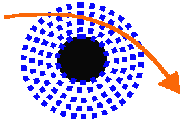 As Star light travels through the Universe, what actually happens is a specific frequency or vibration (a photon) travels along one or more of the flux particle axes strings. The flux particles are arranged in a Field or matrix.
As Star light travels through the Universe, what actually happens is a specific frequency or vibration (a photon) travels along one or more of the flux particle axes strings. The flux particles are arranged in a Field or matrix.
The matrix is held in place by the gravitational effect (the attraction of particles to each other) and curved around any mass in proximity. Light energy or electro-magnetic expansive force adds to the rigidity of the field matrix, but no matter how great the strength of any individual segment of a lattice structure, it is easily folded up or warped by any other force, in this case Gravity.
The Dodecahedron
 The Dodecahedron (DDH) is the pattern or axial arrangement used by the unit Flux. It is stackable hyperbolically and absolutely the most efficient way to pack space with the least amount of material (smallest angle of symmetrical invariance). Any more than ten axes per particle and they won't connect.
The Dodecahedron (DDH) is the pattern or axial arrangement used by the unit Flux. It is stackable hyperbolically and absolutely the most efficient way to pack space with the least amount of material (smallest angle of symmetrical invariance). Any more than ten axes per particle and they won't connect.
The only problem is the vertices are tri-linear (where any axis terminates it will intersect with three others).
If a frequency traveling along an axis passes directly through the center, then out any of the tri-corners, that same linear direction will not pass through any other of the twelve Dodecahedrons in proximity.
 It will be directly on the edge where any four Dodecahedrons meet. So the individual Photon which we now know is one vibration traveling along the Unit Flux strings can never take a straight path. The vertices where the Dodecahedrons meet have four paths.
It will be directly on the edge where any four Dodecahedrons meet. So the individual Photon which we now know is one vibration traveling along the Unit Flux strings can never take a straight path. The vertices where the Dodecahedrons meet have four paths.
If you place three base balls on the ground in a triangle then place another on top to make a pyramid shape, that will be the way the base balls and Dodecahedrons stack. The only problem here is where the base balls touch each other is not where the Unit Flux Strings are located. The end points the Flux Strings terminate on tri-corners. Thus sending the intrepid photon on a Zigzag, Corkscrew, and other intricate paths destined to scatter.
It is easy to angle out of position with nothing else around. It is the combined effect of many photons initially heading in one direction with momentum that keep each other in line and in proper direction except of course near the scattering outer fringes. This is the reason why one photon particle traveling in a zigzag can also be interpreted as wave function. Its path is forced into a wave type motion. A vibration sets off resonant vibrations in itself, perpendicular to the original path. Thus creating other fields and background radiation.
Graviton...38 Dimensions or 10-38 strength



 Drawn here with spherical encasement for clarity, this is the way Flux pack space and are compressed in proximity to a large mass. To complete one wave of pull the gravitational attractor charge takes on its journey, one complete wave of the zigzag must be used to stay in any given direction (remember the Flux axes intersect in groups of four).
Drawn here with spherical encasement for clarity, this is the way Flux pack space and are compressed in proximity to a large mass. To complete one wave of pull the gravitational attractor charge takes on its journey, one complete wave of the zigzag must be used to stay in any given direction (remember the Flux axes intersect in groups of four).
So for this package that's nine dimensional Flux dispersal times four unit Flux or 10-36 strength, if only two paths are used through the group that makes the dimension of the group 10-38 or Gravity.
No problem curving light
 The flux particle field is held in place and curved around any mass in proximity and pulled in and compressed thanks to the lattice type arrangement of the vertices. If the gravitational force is strong enough (an infamous (supposed) Black Hole made entirely of protons or neutrons... same thing et.al.) the Flux will flatten down to an electron like 2-D shape with the normal or volt spike included in the fold, giving the surface structure of the Black Hole the same functionality and appearance as a giant Electron in space.
The flux particle field is held in place and curved around any mass in proximity and pulled in and compressed thanks to the lattice type arrangement of the vertices. If the gravitational force is strong enough (an infamous (supposed) Black Hole made entirely of protons or neutrons... same thing et.al.) the Flux will flatten down to an electron like 2-D shape with the normal or volt spike included in the fold, giving the surface structure of the Black Hole the same functionality and appearance as a giant Electron in space.
Once again Newton's equation
As you approach a Black Hole there will be a dramatic increase in gravity. The zigzag (lattice structure) of particle matrix axes increases, folding up like an accordion. The distance light has to travel increases thereby slowing it, compressing time and space along with it (from an unaffected observers reference frame). But it will take longer and longer to pass through the compressing field so, as the field compresses the overall effect is time will slow down and you will compress along with the field... you might not even notice (until it's too late), you will not stretch out.
(special note: Gravity is the attraction of particles pulling complete groups of atoms together. In a black hole there is a continuous proton / neutron pack and they have shedded their electrons. And although the protons / neutrons are held together with the strong force, i.e. one radius each curled up together, there is nothing to actually compress them together as a group. It would be something like a pearl necklace, any pearl might be strongly connected to its neighbor, but if you folded them up into a ball, there is nothing to collapse them together into a supposed singularity. They are connected but they are not pulling. )
Cosmological Constant: Fifth Force : Dark Energy : Quintessence : Luminiferous Æther : The Aether
The speed of waves of any system is given by the equation:
Velocity "v" of propagation equals the square root of the quantity Tension "T" divided by the Mass "m" per unit length "L" ...
squaring both sides we have:
In our section of the universe, we know the velocity is the speed of light, so let's assume
Even though the values for tension and mass are unknown, it's reasonable to assume the mass of space is vanishingly small (and what is the length?).
Known values (guesses):
Spatial Tension...?
speed of light^2 * electron mass / 10 / (1 angstrom) = 8.18710414 × 10^-5 newtons
Nuclear Tension...?
speed of light^2 * proton mass / (10^(-15) m) = 150,327.731 newtons
speed of light^2 * proton mass / planck length = 9.30131319 × 10^24 newtons
When any flux particle is in free space it has vibration or light energy from billions and billions of stars traversing it in every possible direction. Although every particle is attracted to every other particle... without any large force or vibration on one specific axis, every axis will repel or expand away from every other axis, attempting to expand the whole field to its greatest volume. This process can be considered a universal expansive force, the Fifth Force or Dark Energy.
An easy to understand two dimensional model of the Flux Particle Field would be something like a highly stretched tennis net made of the finest spiders web. And in this model "matter" would be a balled up piece of the web stuck to the net (everything is infinitesimally small). This field is not stationary in space with other things rushing through it like MM mistakenly assumed. It is everywhere and surrounds matter. (note: it might be stationary way out in deep space where there are no planetary, solar and galactic, etc. Movements)
It works in the same type of manner as gravity (a group effort to push or pull in any particular direction) but opposite in force direction. Every particle attracts every other particle but that just creates the field. Nothing can actually happen until an irregularity is introduced into the system, for instance any particle becoming confined as proton mass. Then the field will curve around it and it will be drawn to and/or attract anything in its realm. Gravity and force five ratio varies at different places, for instance near a star there is gravity and a tremendous light energy or expansive force, but on Earth there is gravity and only residual sunlight (expansive force). Gravity ( the actual particle attractions) are the major factor in drawing in a mass and curving the field. The centripetal force along with expansion keep it at bay. Remember... no matter how strong an individual segment of lattice structure, the whole structure is easily curved or warped by any other force. (if something is packing itself around something curved, like the surface of any planet or star, it will... you guessed it, curve.)
Yes, all these things...
Cosmological Constant: Fifth Force : Dark Energy : Quintessence
... are what others have been unknowingly calling the the stretching property of Flux Particle Field.
The field itself (and any loose particles) which completely fill space is unwittingly called Dark Matter: Luminiferous Æther : The Aether etc.
One indivdual particle has been inadvertently called The God particle. etc.
Gravitational Warpage :
 The stretched rubber bed sheet and the bowling ball aren't an accurate model of the gravitational warpage of space... that implies the area nearer the sunken ball is higher density and other masses are attracted to it.
The stretched rubber bed sheet and the bowling ball aren't an accurate model of the gravitational warpage of space... that implies the area nearer the sunken ball is higher density and other masses are attracted to it.
The reverse happens, particles seek a lower density, as in (something like) pressure. You can't say the higher mass or density has a higher gravity because you are using gravity in the example (the explanation) and you can't because in this case it's the question.
In this model "gravity" is causing the acceleration downward not the curve. If you stick this model in space and incline the plane there is no effect. Space (everything) must have a actual field like explained. (Note: my 2-d and 3-d are different from what we're talking about here)
Yes... that whole "gravity is an object following a curved path" gets blown right out of the water by a stationary apple falling straight down from a tree.
The apple path is straight down... that was warped or curved? Ridiculous!
It fell in a straight line. What is the curve: thicker, thinner, pressure? None of those work.
Why would something "curved" cause a pulling effect.
What could the curve be?
No one is going to explain this because it is ridiculous.
Also, if gravity (the actual pulling effect) is caused by a warping of the supposed void of space, there would be a measurable difference in even a miniscule range, for instance the opposite sides of a piece of paper held horizontally. If we stick this whole scenario in a vacuum, the paper would drop like a lead weight, leading us to believe there is an impossible different warp or curve per micro-meter. The force of gravity at the surface of the earth (for instance) and lets say 300 yards up, are about the same, correct? But now if you think of the sheet of paper in a vacuum... there is enough difference even in the range of a micrometer to make it drop like a lead weight? ...there is so much difference/change on the opposite sides of paper that it drops like lead? Does that seem right? Do you see my point?
In a micrometer there is a dramatic difference but 300 yards is the same? No, somethings really wrong with that thinking, it's backwards.
Just about the same "supposed" curve at 300 yards would be negligible
at the micrometer, what's causing the pull?
The picture itself bothers me also... it uses a 2-D model (the sheet) to represent something that can't be represented without sticking a 3-D bowling ball in it and including "gravity" (rolling downhill) without an explanation. And space itself is supposed to be one dimension higher than mass, not less. If you wanted to bump everything down from what is perceived as actuality to those dimensions...
you would have to take a...
Four dimensional space is curved? Where or what is the curve? Is it thicker closer to the source of gravity? Why would something be attracted to a thicker area/density?
Gravity isn't curving space. It's (space is) curved because the Sun or a planet is spherical. If the Sun were an infinitely sized flat object there wouldn't be a curved field but it's safe to assume there would still be what we call Gravity.
P.S. Space is not empty, neither is a vacuum :
Think about it... If there were actually literally nothing in a vacuum... how could there be so much force stopping you from pulling (for instance) a piston out of a cylinder? Why won't it just fly apart?
If you create a vacuum in a lab, what you are actually doing is (almost) evacuating all known matter and you are left with the same highly stretched particle field responsible for gravity and electromagnetic transfer.
It's the same as space... actually not a vacuum in the normal sense.
Neutron star gravitational field...
Different amounts of gravity are just a change in the amount of field connections (gravity is number of field connections)...
one connection per atom (regular matter),
one connection per neutron / proton (neutron / proton star),
just connections (that would be what they say a black hole is).
Atoms are mostly empty space (99.9999999999999 % empty space)
Protons and neutrons are solid?
It says here...
http://imagine.gsfc.nasa.gov/d...
"A neutron star is about 20 km in diameter and has the mass of about 1.4 times that of our Sun.
This means that a neutron star is so dense that on Earth, one teaspoonful would weigh a billion tons!
Because of its small size and high density, a neutron star possesses a surface gravitational field about 2 x 10^11 times that of Earth."
2 x (10^11) = 200,000,000,000
I wanted to find out how big the Sun would be just in neutrons / protons, so...
I divided the radius by 100,000 (that's nucleus to atomic width ratio)
radius of the sun / one hundred thousand = 6.95500 kilometers
note: exact radius would be...
(4 / 3) * 3.1416 * (10^3) = 4,188.8 = (volume of neutron star with radius 10)
cube root(((4,188.8 / 1.4) / 3.1416) / (4 / 3)) = 8.93903535 kilometers = (radius of neutron star with 1.4 times less mass)
==========================
Then I wanted to find how many neutrons would fit in the same size circle as an atomic width (that would be the number of actual field connections).
This should give me the increase in surface gravitational field...
(3.1416 * 100 000^2) / (3.1416 * 1^2) = 10,000,000,000
hmmm... amazing number. It is 1 / 20 the number given by Nasa.
That means to make my number fit exactly I need to multiply it by 20.
Anyone know what that might be...? Why 20 connections more?
What the hell could be made of 20 somethings?
p.s. Black Hole gravitational field works the same way just has a lot more connections, also very easy to figure out.
Update: Here is the answer for Tension of Space:
Tension of Space: T = mc^2/LThe mass of a proton is 1 amu.
The length of 2 radii (or the diameter of an atom) is one angstrom.
That is the equivalent of one string connection in any given direction.
The mass of the 2 radii is 2/20 amu (or 1/10 of the proton).
The speed of light is well known.
Formula for Tension = velocity squared * mass / length.
The really cool thing is you can google this... (speed of light ^ 2 * .1 amu) / 1 angstrom
and the google calculator pops up with the correct answer for the tension of space...
((the speed of light^2) * .1 amu) / (1 angstrom) = 0.14924179 newtons
Can this be theoretically correct? I thought about this some more... If you have 2 weights pulling tension on a string. There would be no way to know the density of the string between them (even if the weights are made of the same type string material). If the string was thick or thin the tension would remain the same. This is what troubled me about just dividing the proton into 20 pieces and using that number as the mass. Although the proton is made from the same string material... the string (mass) itself is not dependent on that. Whatever the string is made from can’t actually be equated directly with mass. It is the smallest scale universal substance.
But then I thought of another possible solution... the difference in the neutron and proton mass. That might actually be the closest mass number available for a string. If the neutron – proton difference is one string radius then 2 of them will equal the atomic diameter.
So I used that in the equation... T = mc^2/L
Tension = c^2 * (2 (neutron mass – proton mass)) divided by angstrom length
speed of light ^ 2 * (2(1.67490 * 10^-27 kg – 1.67260 * 10^-27 kg)) / 1 angstrom
google (speed of light ^ 2 * (2 * (1.67490 * 10^-27 kg – 1.67260 * 10^-27 kg)) / 1 angstrom
All of the neutron strings are balled up. The proton has one string attaching to the electron. That is why it is slightly less mass. It is not 1/ 20th because the individual string mass is the “universal substance” not the same as what is called proton mass.
Here is the google result by the way... google ((the speed of light^2) * (2 * ((1.67490 * ((10^(-27)) kg)) – (1.67260 * ((10^(-27)) kg))))) / (1 angstrom) = 0.00413427382 newtons
The only other alternative available at the moment is electron mass,
(((the speed of light^2) * electron mass) / 10) / (1 angstrom) = 8.18710414 × 10^-5 newtons
But that has charge on it?
All of this is actually easily explained with that new formula... T = mc^2/L
And if we multiply both side by Length...
TL = mc^2
Tension * Length = mass * speed of light squared
That means the Tension of the strings in space times their length is equal to their energy.
"speed of light ^ 2 * .1 amu" ...notice it’s the same as mc^2
speed of light^2 * .1 atomic mass units = 1.4924179 × 10^-11 joules
I guess this is why the speed of light is involved in Einsteins mass energy equivalence equation... E=mc^2
I always wondered why... now I know
It had to be something mechanical... tension and string lengths!
So, you can arrive at the same formula from completely different directions.
You can think energy is contained in mass and released.
E=mc^2
Or you can think there is a field of strings and mass is inert, the energy is only potential… released (actually pulled) by tension on the strings. For anyone that didn’t notice the point, both sides of the new equation TL = mc^2 are equal to Energy...
E = TL = mc^2
Energy = Tension * Length = Mass * Velocity squared
p.s.
The speed of light "c" is how fast the vibration travels
The frequency is the number of vibrations (like cycles per second)
TL = mc^2
mc^2 = TL
c^2 = TL / m
c = square root (TL / m)
The speed of light equals the square root of the quantity... tension of space times the length of string divided by the mass of space.
Note: The Universe must be made of something. This theory assumes the basic unit of Universal Substance is a one-dimensional string. Nothing is Solid. Space is not Empty.